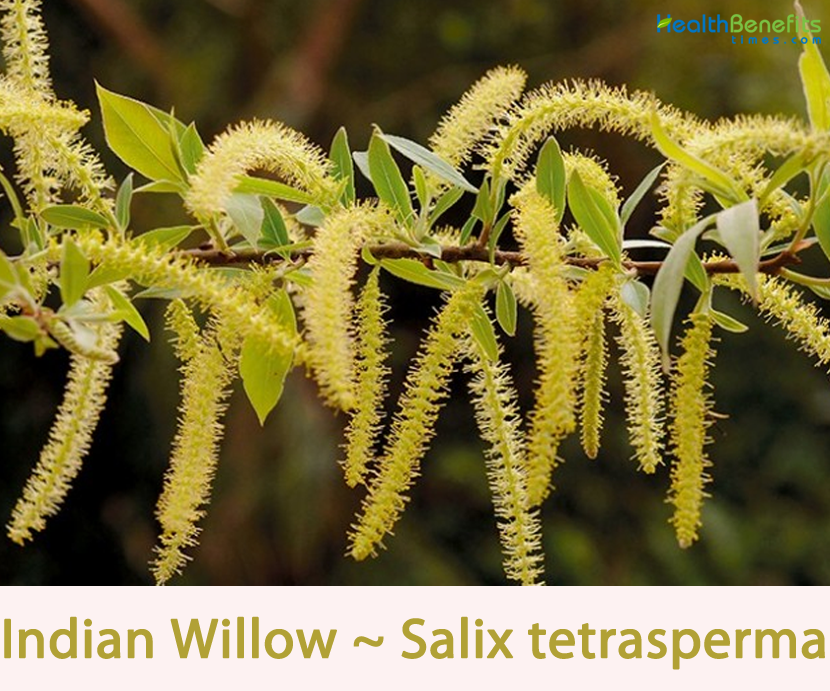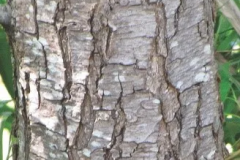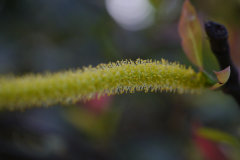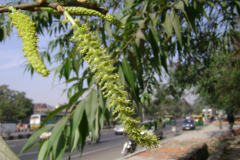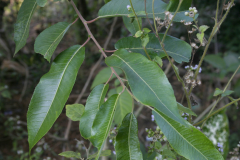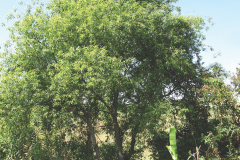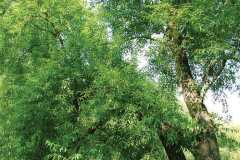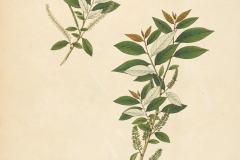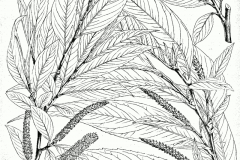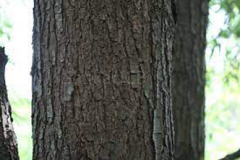| Indian Willow Quick Facts | |
|---|---|
| Name: | Indian Willow |
| Scientific Name: | Salix tetrasperma |
| Origin | From Afghanistan and the Punjab eastwards throughout South-East Asia including India, Pakistan, Bangladesh, Nepal, Laos, Thailand and southern China |
| Shapes | Capsules are long, stipulate, in groups of 3 to 4. |
| Taste | Sweet, bitter |
| Health benefits | Support epilepsy, rheumatism, bladder stones, hemorrhoids, epilepsy, diabetes, hepatitis, piles, wound, ear pain, dysentery, cough and cold, bloody diarrhea, splenomegaly, hepatomegaly and jaundice |
| Name | Indian Willow |
|---|---|
| Scientific Name | Salix tetrasperma |
| Native | From Afghanistan and the Punjab eastwards throughout South-East Asia including India, Pakistan, Bangladesh, Nepal, Laos, Thailand and southern China; in Malesia in Peninsular Malaysia, Sumatra, Java, Lesser Sunda Islands (Bali and Nusa Tenggara), East Kalimantan and the Philippines. In Peninsular Malaysia, only the male sex has been introduced |
| Common Names | Indian willow, Atrupalai, Bains, Niranji, Panijama, Vanchimaram |
| Name in Other Languages | Arabic: Safsaf (صفصاف), safsaf afranjaa (صفصاف افرنجى) Assamese: Bheha (ভেহ), veh Bengali: Biyasa (বিয়াস), Panijama, baishakhi (বৈশাখী), pani jama (পানী জমা) Burmese: Momaka Cambodian: Sampaet Chinese: Si ZI liu (四子柳) English: Indian willow, Atrupalai, Bains, Niranji, Panijama, Vanchimaram French: Saule d’Inde Garo: Bhesh, bol-slak German: Roxburghs Weide Hindi: Badah, Badhla, Baishi, Bhinsu, Pani jama, Sukul bet, Valunja (वाळुंज), Veta, bains, jalvetas, bains, laila, Bod, Jalmala, bed-laila (बेद लैला), bakshel (बक्षेल), bedha (बेधा), begas (बेगस), bent (बेंट), bhains (भैन्स), jalmala (जलमाला), magsher (मगशेर) Marathi: Bachcha (बच्चा), baka (बाका), bitsa (बितसा), bok (बोक) Indonesian: Dalu-dalu, Leri Javanese: Anjang anjang Laotian: Kh’aiz khaw, Kh’aiz ngiwz, Kh’aiz munz Kannada: Baiche mara (ಬೈಚೆ ಮರ), Neeruvanji (ನೀರುವಂಜಿ), Neeranji (ನೀರಂಜಿ), Neerumanji (ನೀರುಮಂಜಿ) Kashmiri: Vir (वीर्) Khasi: Jamynrei Konkani: Walunj (वाळुंज) Malaya: Dalu dalu, Dedalu, Medalu, Mer nalu air, Sendalu Malay: Pokok Dedalu Malayalam: Arali (അരളി), Arrupala (അര്രുപല), Attupala (അട്ടുപല), Nirunchi (നിരുഞ്ചി), Nirunni (നിരുഞ്ഞി), Vanchi (വഞ്ചി), Vanti (വണ്ടി), Vetasa (വെടാസ ), Puzhappanji, vanchi, Vachimaram Malaysia: Dedaln india, nalu air, sendalu Manipuri: Ooyum (ঊযুম) Marathi: Bithsa, Bitsa, Valunja (वाळुंज), Valunja, walunj Mizo: Tuipuisuthlah Myanmar: Momaka, yenè Nepal: Bains Pakistan: Bins Philippines: Bai-bai Punjabi: Bisa Russian: Iva chetyrekhsemyannaya (ива четырехсемянная) Sanskrit: Nadeya, Jalavetasaḥ (जलवॆतसः), Vanira, Vanjula, Vetasa, naadeya, Jalvetas, nadeya (नादेय), vanira (वानीर), vanjula (वञ्जुल), varuna (वरुणा) Santal: Gada Sinhalese: Saliks tetrasperma (සලික්ස් තෙත්රස්පෙර්ම) Sundanese: Kapeh kapeh Tamil: Celamakitam, Celamakitamaram, Cuvetavanci, Cuvetavancimaram, Vanci, Vancimaram, Vanji, caliks (சாலிக்ஸ்) Ṭeṭrāsparmā (டெட்ராஸ்பர்மா), Artupalai, Nirvani, arru-p-palai (ஆற்றுப்பாலை), cuvetam (சுவேதம்), nir-vanci (நீர்வஞ்சி) Telugu: Etipaala, Etipisinika, Vodime, konda ganneru (కొండగన్నేరు) Thai: Sanun (สนุ่น), Tanun (ตุ หนุ่น), Ta khrai bok (ตะไคร้ บก), Snun (สนุ่น), Ta krai bok, Khrai, Khrai nun, sanun nam (สนุ่นน้ำ), tanun (ตะหนุ่น), khrai yai (ไคร้ใหญ่), khrai (ไคร้), nga-lu (งาลู), da-lu (ดาลู), ma-da-lu (มาดาลู), takhrai bok (ตะไคร้บก), sanun (สนุ่น), khrai nun (ไคร้นุ่น), khrai bok (ไคร้บก) Urdu: Burg baid sada |
| Plant Growth Habit | Small to medium sized deciduous tree |
| Growing Climates | Swampy areas, on river islands, and on the banks of water courses |
| Soil | Grows on a variety of rich, sandy loam soils that are well drained |
| Plant Size | 6 to 12 m tall with diameters of 0.4 to 1.0 m. |
| Bark | Bark is rough, with deep, vertical fissures and the young shoots leaves are silky |
| In Leaf | October–December |
| Leaf | Leaves are lanceolate, 8 to 15 centimeters long, with minutely and regularly toothed margins |
| Flowering season | December – March |
| Flower | Male sweet scented catkins are 5–10 cm long, and are borne on leafy branchlets. The female catkins are 8–12 cm long. |
| Fruit Shape & Size | Capsules are long, stipulate, in groups of 3 to 4 |
| Taste | Sweet, bitter |
| Plant Parts Used | Bark, leaves, roots, flowers, stem sap |
| Season | April |
| Culinary Uses |
|
| Precautions |
|
Plant Description
Indian Willow is a small to medium sized deciduous tree that normally grows about 6 to 12 m tall with diameters of 0.4 to 1.0 m. The trunk is erect, with a large crown. The bark is rough, with deep, vertical fissures. The young shoots and young leaves are silky. It is a light-demanding species, which may tolerate a wide range of climatic conditions. It is usually found along watercourses and in other moist areas, therefore in drier areas its growth is not dependent on rainfall. Normally the plant prefers wet and swampy places. Shedding of its leaves start at the end of monsoon season.
Leaves
The leaves are lance-like, or ovate-lance like, 8–15 cm long, with minutely and regularly toothed margins. It flowers after leafing.
Flowers
Indian Willow is dioecious plant. The male and female catkins are borne on leafy shoots. The sweet scented male catkins are 2.5 to 12.5 cm long and are borne on leafy branchlets, while the female catkins are 2.5 to 12.5 cm long. Flowering and seed production occurs between February and May. It does coppice.
Fruit
Fertile flowers are followed by capsules that are long, stipulate, in groups of 3 to 4. Normally 4 to 6 seeds are found in a capsule.
Distribution
The tree is native to the sub-continent including Pakistan. It occurs in swampy areas, on river islands, and on the banks of water courses. In Pakistan it is found in the Murree hills, Kahuta, Hazara, Swat, Azad Kashmir, Quetta, Kurram and Gilgit. It has been successfully planted in the plains of Afghanistan and in the Peshawar valley. It is an intolerant tree that grows on a variety of rich, sandy loam soils that are well drained. It is adapted to a precipitation zone of 750 to 1250 mm/yr. or more, within an elevation range of 300 to 1600 m and within a temperature range of -10 to 40°C. It prefers a sub-humid, semi-arid, sub-tropical, monsoon to temperate climate and is frost hardy.
Ethno botanical uses of Indian Willow (medicinal uses)
| Location | Uses |
| Central Punjab, Pakistan | Bark is used as febrifuge |
| Bangladesh | Febrifuge |
| Nagaland, India | Decoction of bark is used in fever |
| Tharu tribes, Himalayan Terai region of India | Bark in fever; Leaves with sugar in rheumatism, epilepsy, venereal diseases, Wild bladder stone, piles and swellings |
| Kozhenchery Taluk, Pathanamthitta District, Kerala, India | Rheumatism, Antiepileptic, Swelling, Piles, Venereal diseases, Stones in bladder |
| Indo-Burma region, India | Bark is febrifuge |
| Neelum Valley, Azad Jammu and Kashmir, Pakistan | Anodyne and febrifuge |
| Wayanad, Kerala, India | Roots are used in diabetes |
| District Bannu, Khyber Pakhtunkhwa, Pakistan | Leaves poultice to wounds, leaf juice for ear pain, roots in cough and cold, seeds in dysentery |
| Western Mizoram, India | Bark is used as febrifuge |
| Karamar valley, district Swabi, Pakistan | Bark is used in fever and leaves for piles and rheumatism |
| Meghalaya, northeast India | Bark febrifuge; dried and powdered leaves with sugar in rheumatism, epilepsy, piles, swellings, stones in bladder |
| Lahaul valley, Himachal Pradesh, India | Fever |
| Dehradun, India | Fever |
| Jalgaon district, Maharashtra, India | Management of wounds |
Ethno-botanical uses of Indian Willow (non-medicinal uses)
| Location | Uses |
| Wayanad wildlife sanctuary, Kerala, India | Twigs are used for making basket |
| Mao-Naga tribe, Manipur, India | Log of the plant is used for making traditional utensils.
Plant is grown as soil binder on embankments. |
| Agra Valley Parachinar, upper Kurram agency, Pakistan | Wood is used as fuel and in making agricultural tools |
| Siran Valley, District Mansehra, Pakistan | Construction, furniture, fencing, roofing, fuel wood |
| Ashezai and Salarzai Valleys, District Buner, Pakistan | Wood |
| Sargodha district, Punjab, Pakistan | Ornamental |
| Chagharzai valley, district Buner, Pakistan | Fuel wood, timber, roofing material |
| Dawarian village, Neelum valley, Azad Jammu and Kashmir, Pakistan | Used as fuel, foliage is used as fodder, wood is used as making sport articles |
| Himachal Pradesh, India | Used in making agricultural equipment and house construction, as timber |
| District Ghizer, Gilgit, Baltistan | Leaf is used as fodder, stem is used as fence and fuel |
| Ghulamo tibmber market Mardan, Khyber Pakhtunkhwa, Pakistan | Timber and fuel |
| Allai valley, district Battagram, Pakistan | Fuel and timber |
| Temperate zones of Pakistani Hindukush-Himalaya | Stem is used as fuel wood; leaves are used as fodder |
| District Rajouri, Jammu and Kashmir, India | Shoot looped for cattle fodder |
Traditional uses and benefits of Indian Willow
- On the Malay Peninsula a cold decoction of the leaves is used as a lotion for an ulcerated nose.
- Bark is used to treat fever.
- It is used in Egyptian folk medicine as anti-rheumatic sedative and analgesic.
- Leaves and bark is used as remedy for aches.
- Paste of both leaf and root is used externally for scorpion stings, bug bites, sores and warts.
- Decoction of dried root is taken internally for treatment of hepatitis.
- In Pakistan, bark is used as febrifuge; leaves used to poultice wounds.
- In India, bark used for epilepsy, rheumatism, bladder stones, hemorrhoids, epilepsy; roots used for diabetes.
- It is used to treat rheumatism, piles, VD, bladder stones, epilepsy and swelling.
- In Bangladesh, bark decoction of Indian Willow is used to bring down high body temperature (fever).
- Ethno-medicinally, the plant is used to treat ailments such as diabetes, fever, piles, epilepsy, rheumatism, swellings, and stones in bladder, wound, ear pain, dysentery, cough and cold.
- Leaf juice is used to treat bloody diarrhea, splenomegaly, hepatomegaly and jaundice.
- Leaves are dried, powdered and used along with sugar to treat rheumatic arthritis, swelling, epilepsy, venereal diseases, bladder stone and piles.
- Sap of the stem is used orally to treat painful menstruation.
- Roots are used to treat diabetes, cough and cold.
- Decoction of the roots and leaves are used to treat whooping cough in kids.
- Dried leaves possess cardio tonic and neuro-tonic activity.
- Leaf and root paste is applied externally to heal wounds, warts, sores, scorpion stings and bug bites.
- Leaf juice is used as ear drops to heal ear pain.
- Hot water extract of the entire plant is used in vaginal canal to induce abortion and used rectally to treat sores in the rectum.
- Tribes of the Keonjhar district of Orissa drink the bark paste properly suspended in water to treat diabetes mellitus.
- Its bark has been used in traditional medicine in many countries to alleviate pain, fever, and inflammation.
- It also strengthens the heart and can be given in bleeding disorders.
- It can also be given to reduce hematemesis, bronchiectasis and dyspnea.
- Its decoction is used in piles to reduce pain and stop bleeding.
- It acts as a digestive and reduces water content from the fecal matter.
- It acts as a diuretic and hence can be given in dysurea and renal stones.
- It acts as an aphrodisiac and can be given in problems related to nightfall. (20 drops half an hour before sleeping taken along with 30 ml of water)
- It also relieves vaginal problems.
- It is helpful in hyper pyrexial conditions.
- It is used in eye irritations and headaches.
Other Facts
- It is planted along water courses to prevent erosion.
- It is used for making cricket bats and light furniture.
- Soft twigs are used in weaving of baskets.
- Woods are used as a good gun-powder-charcoal, used for making of Cricket bats.
- The non-medicinal applications of the plant includes the use of plant as fodder, soil binder on embankments and fuel and in making baskets, agricultural tools, sports articles, furniture and roofing material.
- Planted on the bunds of wet rice fields in Peninsular Malaysia for soil protection.
- It is also planted in regularly pollarded and coppiced hedges to delimit field boundaries.
References:
https://gd.eppo.int/taxon/SAXTE
http://www.theplantlist.org/tpl1.1/record/tro-28300561
http://www.stuartxchange.com/Malatiki
http://www.flowersofindia.net/catalog/slides/Indian%20Willow.html
https://indiabiodiversity.org/species/show/261494
https://www.cabidigitallibrary.org/doi/10.1079/cabicompendium.48709
https://uses.plantnet-project.org/en/Salix_tetrasperma_(PROSEA)#Synonyms
http://www.worldfloraonline.org/taxon/wfo-0001133625


